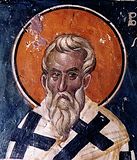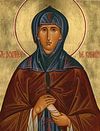

| Previous day | Next day |
| Old Style
February 6
|
Monday |
New Style
February 19
|
|
1st Week of Great Lent.
Tone 4.
Great Lent. |
Monastic rule: total abstinence from food.
|
![]() St. Bucolus, bishop of Smyrna (ca. 100).
St. Bucolus, bishop of Smyrna (ca. 100).
Virgin-martyr Dorothea, and with her Martyrs Christina and Callista, sisters, and Theophilus, at Caesarea in Cappadocia (288-300). Virgin-martyr Fausta, and with her Martyrs Evilasius and Maximus, at Cyzicus (305-311). Martyr Julian of Emesa (312). Sts. Barsanuphius the Great and John the Prophet, monks of Gaza (6th c.). St. Photius, patriarch of Constantinople (891). Virgin-martyrs Martha and Mary and their brother Lycarion at Tanis (Hermopolis) in Egypt. St. Dorothea, schemanun, of Kashin (1629).
New Hieromartyr Dimitry Rozhdestvensky, archpriest, of Verny, and his son New Martyr Anatole (1922). New Hieromartyr Basil Nadezhnin, priest, of Moscow (1930).
St. James, ascetic, of Syria (ca. 460). St. Mael, bishop of Ardagh (488), disciple of St. Patrick. St. Vedast, bishop of Arras (540). St. John of Thebes, monk of Palestine (6th c.) St. Amand, apostle of Maastricht (675). St. Arsenius of Iqalto, Georgia (1127).
Repose of Archbishop Theophan (Bystrov) of Poltava (1940).
Thoughts for Each Day of the Year
According to the Daily Church Readings from the Word of God
By St. Theophan the Recluse

Monday (1st Week of Lent).
“Lent has come, O mother of chastity.” What was the time before this day? A time of fornication.[1] The soul fornicated with all that struck its eye as pleasant—both with people and with things: more fully, with sinful passions. Everyone has his passion which he pleases in all he does. It is time to put an end to this. May each of you comprehend your Delilah, who binds you and hands you over to evil enemies, and abandon her. Then you will be given more than Samson: not only shall your hair grow, but so also shall good thoughts; and not only shall your strength return, but so also your strength of will. Your eyes shall also open, your mind shall have sight and it shall see the Lord, yourself, and everything around you in the proper light. This is the favourable time! This is the day of salvation!
[1] “A time of fornication.” Fornication here has a double meaning in Russian, both of fornication and roaming.
Articles
 St. Bucolus the Bishop of SmyrnaSaint Bucolus, Bishop of Smyrna, was a disciple of the holy Apostle and Evangelist John the Theologian, and became the first Bishop of Smyrna (Asia Minor). |
 Virginmarty Fausta at CyzicusThe girl bravely confessed her faith and was subjected to many cruel tortures. |
 Martyr Evilasius at CyzicusSaint Evilasius was an eighty-year-old pagan priest who was ordered to turn Saint Fausta away from Christ. |
 Martyr Maximus at CyzicusThe eparch Maximus was sent to investigate the case of Saints Fausta and Evilasius for the emperor, and he began to torture the old man who had come to believe in Christ. |
 Martyr Julian of EmesaHe was a skilled physician, and healed illnesses not only of the body but also of the soul, and he converted many people to faith in Christ the Savior. |
 Venerable John the ProphetSaint John, a disciple of Saint Barsanuphius, lived in a cell outside the monastery of Abba Seridus for eighteen years until his death. |
 St. Arsenius of Iqalto in GeorgiaSaint Arsen of Iqalto was a translator, researcher, compiler of manuscripts, hymnographer, philosopher, and a great defender of the Georgian Christian Faith. |









